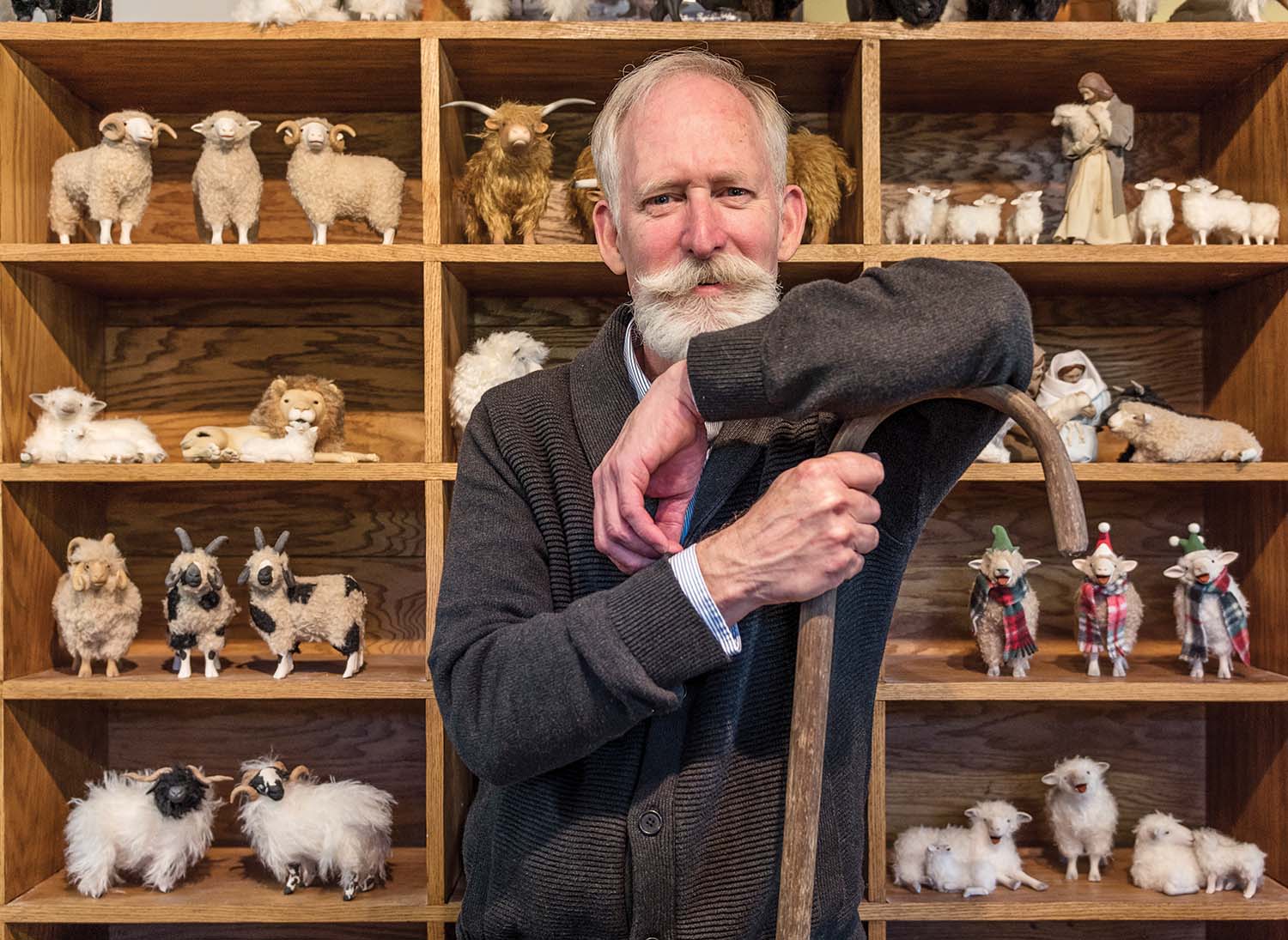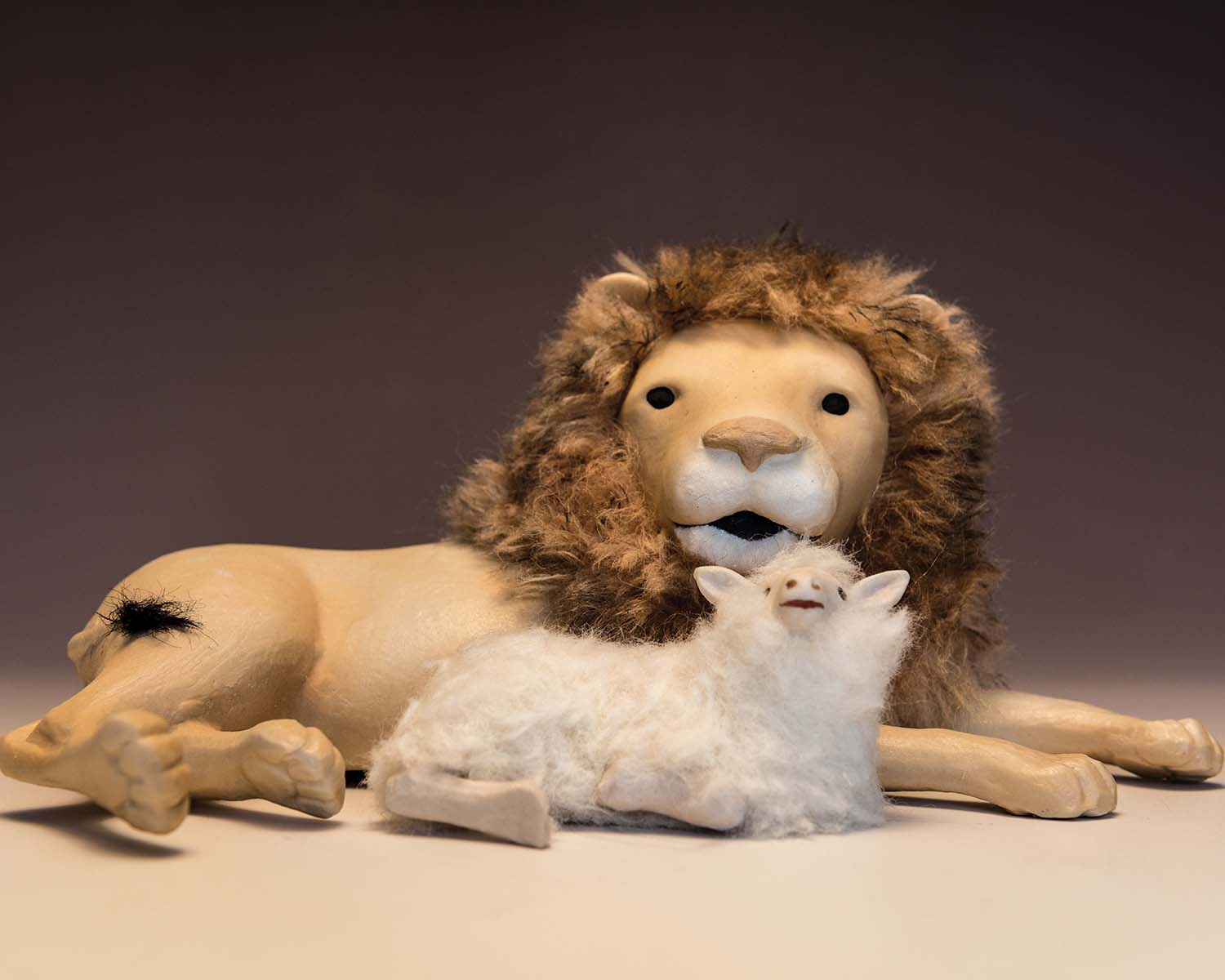
Colin Richmond has had to stop counting his sheep. “My flock has gotten too big to remember without checking my website,” he admits. “I have no idea how many items I make.” Over the past two decades, under his Colin’s Creatures banner, he’s created thousands of porcelain-and-wool sheep figures. And except for a brief period of rapid growth early in his flock’s history, he’s carved and cast every piece himself
Richmond’s first “creatures,” though, were angels whose delicate porcelain features were adorned with moiré fabric. That was back in the early 1990s, when he and his wife had just moved to Asheville after Richmond turned his back on his New York career as a corporate business consultant.
“It was fun in my twenties, but I found it very unsatisfying,” recalls Richmond, who recently turned 60, of those suit-and-tie years. “My father was an avid painter and sculptor, so I grew up in an environment with lots of eye candy, lots of visual stimulation.” Influenced by his father’s enthusiasm for Alexander Calder’s mobile constructions and their inventive use of form and texture, Richmond contemplated making his way in the fine arts but decided that artisanal craft — with its direct line to the public, rather than through agents and dealers — gave him a greater chance of a supportive career.

After bringing his angels to his first craft show at the 1993 Atlanta Gift Market, Richmond came across a magazine article about German antique models of sheep made from leather, wood, and wool. “The mixed-media design sounded totally consistent with my approach on the angels, so I made two breeds of sheep,” he recalls. At the time, he knew nothing about sheep except “they had fluffy parts and non-fluffy parts.”
But they turned into his biggest sellers — and grew into a big-enough business that, at one point, Richmond’s sheep were on the shelves of more than 800 stores nationwide, and he had a staff of four employees to help carry the load. “It felt like being back in the corporate world,” he says. “I spent all my time managing my employees and had no time to be creative. So I downsized.”
Now, he makes all his sheep and other figures by his own hand, carving the original of each animal from which he makes the molds for casting — plaster molds for the porcelain sections of each body and rubber ones for other parts. The fur is attached with the same adhesive used to make lampshades. “The most difficult skills are probably the use of the fur, where it stops and starts and how it needs to be managed to look real,” Richmond says.

The fiber is supplied by a distributor for Steiff, the venerable German maker of teddy bears and other plush toys. For a lifelike appearance and tactile appeal, Richmond uses a repertoire of more than a dozen woven furs for his sheep and one or two mohairs for a smaller line of cattle figures. “The first big lesson I learned with the sheep was that to have any shape show up after the fur was added, the curves really had to be accentuated on the body,” Richmond says. “Otherwise the figure would just be a blob.” Equally challenging was figuring out how to carve mirror-image symmetrical rams’ horns for his figures and how to attach them.
Richmond’s knowledge of heritage breeds of sheep and cattle lend variety and authenticity to his menagerie. When he had a studio in England, he was drawn to agricultural fairs where Britain’s 60 native breeds were on show. The fairs became research, and for a time, Richmond was an active member of Britain’s Rare Breeds Survival Trust. “The royal shows in Britain are wonderful, but I’ve pretty much exhausted them, although I do plan to visit the islands north of Scotland sometime,” he says.
Today, his figures are stocked by about 50 stores around the country. Orders come from as far away as New Zealand and Japan, and some customers are second- and third-generation collectors. The figures have become family heirlooms; one young woman who inherited a collection from a much-beloved grandmother calls Richmond several times a year to tell him how much the flock means to her. “I do get a remarkable number of touching letters and e-mails,” he says. “The sheep really speak to people on a level way beyond what I ever imagined.”
Colin Richmond, Asheville. See colinscreatures.com for inventory and more information. Studio visits are available by appointment: 828-215-6006.

Congratulations Colin. A nice article about an amazing man! I have collected your sheep and lambs since the early 90s, and now my daughter-in-law loves them — I give her some of your collection every Christmas.
Continued success to you!
Rebecca Hensley